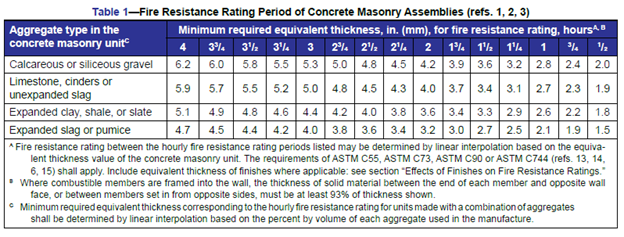by Reid W. Castrodale, PhD, PE, and Kevin Cavanaugh
Fire resistance of structures is an important part of designing for resilience. In the last few years, many wood-framed apartment and condo buildings have caught fire and suffered severe damage, even to the point of being total losses. Many occurred in buildings that were still under construction. Others occurred in occupied structures that had fully functioning fire safety features operating that failed to control the fires. In buildings, non-combustible fire walls that contain fires to their points of origin are a key feature in the Balanced Fire Safety Design concept.
Structural lightweight concrete and lightweight concrete masonry units offer the best fire resistance of the structural concretes typically used in buildings and in infrastructure projects. Table 1, based on ACI 216.1-14, clearly illustrates that thinner wall, floor or roof concrete thicknesses are needed when using structural lightweight concretes made with ESCS LWAs.
There have also been several examples of bridges that have been exposed to fires on or beneath them that have resulted in significant delays for the traveling public until the bridge was replaced. These disasters generally destroy or significantly compromise the strength of the structures, and often result in the complete replacement of the structure at a great cost in time, money, and traffic delays, and in some cases human suffering or even loss of life.
While structural lightweight concrete or lightweight concrete masonry units (CMU) are often used in projects for other reasons, lightweight concrete elements provide significant benefits related to fire resistance. ESCSI has published Tech Note #16 (TN16) “Fire Resistance of ESCS Structural Lightweight Concrete,” to provide information to designers regarding the fire resistance of building structures that incorporate structural lightweight concrete. The information can also be applied to other types of structures that are at risk of fire exposure, such as bridges.
Structural Lightweight Concrete
The following table, which appears in ESCSI’s TN16, demonstrates the improved fire resistance of structural lightweight concrete slab elements compared to elements constructed of conventional normal weight concrete.

The data in Table 1 demonstrate that lightweight concrete is more effective in resisting the effects of fire exposure than conventional normal weight concrete because the thickness of lightweight concrete required to achieve the same fire resistance rating is less than for conventional concrete. Another way of looking at the data provided in Table 1 is to recognize that lightweight concrete will provide increased fire protection compared to an equal thickness of conventional concrete. From the values in the table, it appears that lightweight concrete provides a roughly 50% increase in fire resistance rating compared to the same thickness of conventional concrete.
Lightweight Concrete Masonry
The information in Table 1 applies only to monolithic concrete slabs but is typical of the improved fire resistance of other types of lightweight concrete elements, including concrete masonry units (CMU) and CMU wall assemblies. Information on concrete masonry fire ratings is contained in the Concrete Masonry and Hardscape Association (CMHA) TEK 07-01D “Fire Resistance Ratings of Concrete Masonry Assemblies,” as in the table below. This table shows improved fire ratings for lightweight concrete masonry, similar to the improvements for structural lightweight concrete. The improvement is more pronounced as the fire resistance rating increases.

Conclusions
Based on the limited data presented in this article, it is clear that where fire resistance is considered when designing a structure, the use of lightweight concrete improves the fire resistance, and may allow for a reduction in the quantity of concrete required to construct the structure. Please consider the listed references or contact members of ESCSI for additional information.
References
ACI 216.1-14/TMS 216.1-14, “Code Requirements for Determining Fire Resistance of Concrete and Masonry Construction Assemblies,” 2014.
Expanded Shale, Clay and Slate Institute (ESCSI), Publication #7900.2, Tech Note #16 (TN16), “Fire Resistance of ESCS Structural Lightweight Concrete”, 2021.
ESCSI, Publication #3220.2, “Fire Resistance of Expanded Shale, Clay and Slate Concrete Masonry,” 2014.
National Concrete Masonry Association (NCMA), TEK 07-01D, “Fire Resistance Ratings of Concrete Masonry Assemblies”, 2018.